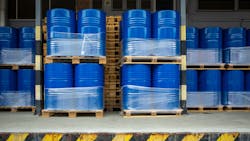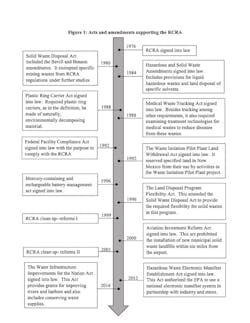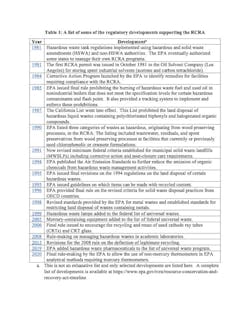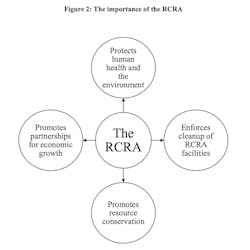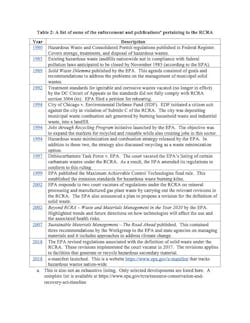What is the Resource Conservation & Recovery Act (RCRA)?
Definition & General Aspects of RCRA
The Resource Conservation & Recovery Act (RCRA) is a law and it is the framework for managing hazardous and non-hazardous solid wastes. It is one of the most important laws in light of the increasing amount of solid waste generated regularly and it also encourages efficient cleanup innovations. RCRA is also invested in integrating resource conservation into the U.S. economy to contribute to the economic growth.
History of RCRA
RCRA was signed into law on October 21, 1976. It was an amendment to the Solid Disposal Act of 1965 which was the first statute focused on improving methods for solid waste disposal. Since its amendment, several acts were established to support the law. In addition to RCRA cleanup reforms in 1999 and 2001, it has been in the public eye for its encouragement on public participation in several of its key decisions and for its enforcement. Historical developments in the law are presented in Figure 1 (right) while Tables 1 and 2 (below) highlight the regulatory activities and public reports and enforcement, respectively.
The Plastic Ring Carrier Act of 1988 was legislated due to the concerns about non-degradable circular plastic devices, consisting of at least one hole greater than 1.75 inches, getting entangled in aquatic fish and wildlife. The Act required these items to be made of naturally degradable material within a timeframe specified in the regulations for this Act.
It also included providing the public with greater access to information on the cleanup progress for the RCRA facilities. The 2001 RCRA reforms built on the 1999 RCRA reforms by supporting states and EPA regional offices to use innovative cleanup approaches for facilities and also to connect the communities with cleanup efforts. This included providing the communities with the Technical Outreach Services for Communities (TOSC) program. This program provides communities with educational assistance from universities on issues about cleanup for hazardous sites.
The 2001 Reforms also included an important aspect − capitalizing on the potential for redeveloping cleaned RCRA sites and the EPA’s proposal to launch the RCRA Brownfield pilot projects. The EPA’s Brownsfields and Land Revitalization Program, established in 1995, provides grants for the cleanup and also for sustainably reusing brownfields which, according to the EPA are contaminated properties that have the potential for reinvestment and could contribute to the economic growth.
In addition to the two reforms, the history of the RCRA also includes the revisions on the definition of legitimate recycling (40 CFR 260.43) in 2015 – in general to address verified recycler exclusion, i.e. the exclusion of secondary hazardous wastes from the definition of solid waste if the material is reclaimed by a facility that has the required RCRA permits or has received a variance from the EPA according to 40 CFR § 260.31. Recent developments pertaining to the RCRA includes revising user fees to recover the cost of operating the e-manifest system – a website for tracking the shipment of hazardous wastes. It was established in accordance to the Hazardous Waste Electronic Manifest Establishment Act of 2012 (also known as the e-manifest Act). All generators, transporters, and receiving facilities of hazardous wastes (that fits the legal definition of hazardous wastes in the RCRA) must register in e-manifest.
Why is RCRA Important?
The RCRA influences several facets of society – from human health and the environment, to the cleanup of contaminated sites, to resource conservation and economic growth, and these are outlined in Figure 2. It is one of the most important legislation in the United States that enforces cleanup, while it also promotes resource conservation and partnerships for creating jobs, particularly in the waste recycling sector.
The RCRA is a regulatory framework for waste management including for hazardous waste in the RCRA subtitle C program. This comprehensive program, in addition to tracking hazardous wastes nationwide, also requires waste generators (who have the required RCRA permits) to annually certify that they have a program in place to reduce the volume and toxicity of the waste.
In addition to the RCRA hazardous waste permitting program that monitors performance to assure compliance with the permits, there is also the obligated long-term stewardship for waste disposal. This is what this stewardship is about: facilities that manage waste, after they are done with the management as per the contract, conduct post-closure activities that could include deconstruction of tanks or final capping of landfills. After post-closure, since the waste is left in place (e.g. in landfill), there is a need to monitor it and thus, the long-term stewardship involving public and private stakeholders. The EPA, states, tribes, and local government are also involved in the long-term stewardship. The EPA, which enforces the RCRA, provides waste management expertise for disasters and also emphasizes on recycling and reuse of debris generated due to the disasters.
Enforcing Cleanup – the RCRA Corrective Program
Under the RCRA Corrective Action Program, facilities that manage hazardous wastes are required to cleanup any release of hazardous constituents at the owner’s expense. This program also obliges permitted waste generators to cleanup old waste.
There are two steps to implement the RCRA Corrective Action Program: stabilization measures and the corrective measure. In the first step, policies are put in place to prevent short- and long-term exposures from contaminated sites. The second step is an advancement of the first step. This step engineers and implements remedies such as land restriction to protect from the exposure to hazardous constituents. The EPA and the states use the permitting programs and laws to take these two steps. In 2014, the RCRA Corrective Action Program applied to 76% of the priority sites (specifically called the RCRA Corrective Action sites) to protect the public from exposure to contaminated groundwater.
The Sustainable Material Management Program
The EPA and some of the states are involved in the Sustainable Material Management (SMM) Program, a material management approach that considers the entire lifecycle of material with the objective to minimize the environmental impact of the hazardous constituents in the material. Examples of practices in the SMM program include the retirement of mercury-containing devices and the reformulation to produce products such as lead-free PVC products.
Partnering for Economic Growth
One of the focuses of the RCRA cleanup program is to engage with local communities and stakeholders so that they can participate in decisions about hazardous waste management including on cleanup efforts and emergency preparedness and response. The public can also participate in permit decisions.
For disadvantaged communities, the RCRA encourages conversations to understand the needs of these communities and to listen to their feedback to make effective and sustainable decisions to protect them from the effects of hazardous wastes. Additionally, the RCRA program also works in collaboration with tribes to support the development and implementation of tribal solid waste programs such as the Integrated Waste Management Plans.
International collaborations involving the RCRA include the Organization for Economic Development (OECD). The RCRA manifest applies to shipments from OECD member countries listed by the EPA and this manifest contains information on the type and quantity of waste transported along with information for handling the waste.
Importance of the RCRA for the Future of Waste Management
As the population grows, more waste will be generated and there will be more demand to conserve natural resources. Waste management and resource conservation are included in the key aspects of the RCRA. The RCRA also encourages technological innovations for the cleanups of contaminated areas and also economic productivity via recycling. These key points are the reasons why the RCRA will be needed more than ever before in the future – it uses waste management as a leverage to integrate cleanup innovations and resource conservation into economic productivity.
What is Considered RCRA Waste?
The RCRA covers a whole spectrum of wastes and these are listed in the definitions in Title 40, Chapter I, subchapter I, part 243. These include agricultural solid waste, bulky waste, and commercial and industrial solid waste. Generally, the wastes could be divided into hazardous and nonhazardous wastes and guidelines for managing both of these wastes are in the subchapter.
What Does RCRA Hazardous Waste Mean?
The definition of hazardous waste under RCRA is in 40 CFR Part 260 subpart B. A solid waste is a hazardous waste if it meets the criteria listed in the above mentioned CFR and one of the criteria is fitting into the characteristics of hazardous wastes (§ 261.21 to § 261.24). Also, depending on their source of origin, hazardous wastes are assigned a letter listing (§ 261.31 to § 261.33). Both of these are further described in the following sections.
Characteristics of hazardous wastes
The following are the EPA hazardous waste identification numbers:
- For ignitable hazardous waste: D001;
- For corrosive hazardous waste: D002; and
- For reactive hazardous waste: D003.
If a solid waste has the toxicity characteristic, determined from the EPA test method’s results, then it is given a hazardous waste number specified in Table 1 (above) under § 261.24 (b). This table, besides a list of organic and inorganic contaminants, also provides regulatory level values.
These values are not the same as the maximum concentration level (MCL) values in the National Primary Drinking Water Regulations. Rather, these regulatory values are values to determine if the waste, if it contains the listed chemical, is toxic. For example, the regulatory level of arsenic, listed in the CFR’s table 1 is 5 mg/L. The MCL for arsenic is 0.010 mg/L. Similarly, the regulatory level for carbon tetrachloride in the table is 0.5 mg/L while its MCL value is 0.005 mg/L and for mercury, the regulatory level in the table is 0.2 mg/L while its MCL value is 0.002 mg/L. The regulatory values in these examples are higher than the MCL values.
Listing of Hazardous Wastes
Depending on their source of origin, hazardous wastes are assigned into one of the three letter listings: F list, K list, or P/U list. Part 261, subpart D contains a list of chemicals in the pertaining tables for each of these lists.
The F list consists of hazardous wastes from non-specific sources (§ 261.31). It has seven categories and examples of wastes include spent solvent and wastes from electroplating operations.
Hazardous wastes from specific sources are in the K list (§ 261.32). It has 13 categories and include wastes such as from wood preserving and from petroleum refining.
Chemical wastes that are discarded such as spill residues are in the P/U list (§ 261.33). Benzyl chloride and lead acetate are examples of wastes in the P/U list.
California’s List & Additional Characteristic for Toxicity
An additional list, the M-list for discarded mercury-containing wastes, applies in the state of California (22 CCR section 66261.50). It includes mercury-containing thermometers, switches, and relays. The wastes are categorized into one of the following four lists:
- M001: contains mercury light switches from automobiles;
- M002: contains other mercury switches from appliances;
- M003: contains mercury-containing lamps and other products except LCDs with backlight lamps that contain mercury; and
- M004: other mercury-containing wastes.
California also has additional tests for determining the toxicity of wastes – the Waste Extraction Test (WET) and the total digestion procedure. The results from these tests are compared with the regulatory limits discussed above.
Is all RCRA Waste Hazardous?
No, not necessarily. The RCRA waste could also be non-hazardous, mentioned before in this article. RCRA subtitle C focusses on hazardous wastes while subtitle D focusses on non-hazardous wastes. Subtitle C (40 CFR Chapter I, subchapter I, Parts 260-273) in addition to the definition of solid waste, also includes the characteristics of hazardous wastes, described above in this article. Subtitle D (40 CFR Chapter I, subchapter I, Parts 239-259) includes guidelines on the storage of solid waste and criteria for the classification of solid waste disposal facilities (Part 257) and municipal solid waste landfills (Part 258).
The Difference Between 42 USC § 6901 & 40 CFR Parts 260-273
In regard to Subtitle C of the RCRA, notably some reference sources mention that this is located in 42 USC § 6901 while others mention this is located in 40 CFR Parts 260-273.
What is the difference? The former is on the Solid Waste Disposal Act while the latter covers regulations for the RCRA. Subtitle C of RCRA, enacted in 1976, replaced the Solid Waste Disposal Act and the Resource Recovery Act.
So RCRA (the Act) is in 42 USC § 6901, while the regulations are in 40 CFR Parts 260-273 and these regulations apply to solid wastes in general and the RCRA specifically.
What is the Difference Between RCRA Waste & Non-RCRA Waste?
If the waste is regulated by the RCRA, then it is known as an RCRA waste otherwise, it is a non-RCRA waste. RCRA wastes are discussed above in this article. Both RCRA and non-RCRA wastes are also regulated by several states. For example, the Connecticut General Statue CGS section 22a-448 and the California Title § 66261.101 are for non-RCRA hazardous wastes.
Who Can be Held Liable Under RCRA?
Owners and operators of hazardous waste treatment, storage, and disposal facilities (TSDFs) can be held liable as 40 CFR part 264 and 265, subpart H mentions that they are required to maintain accident liability insurance. This liability coverage ensures that third parties who may be physically harmed or have property damage due to the release of hazardous constituents from TSDFs are compensated. There is a mechanism in place that the owner/operator of the TSDF follows to demonstrate liability coverage.
Federal facilities are also subject to liability in regards to the disposal and management of solid and hazardous wastes. The Solid Waste Disposal Act, the Federal Facility Compliance Act, and the RCRA Section 6001 (a) all waive sovereign immunity for federal facilities in this regard.
RCRA authorizes the EPA to require corrective actions for TSDFs when they release hazardous chemicals into the environment. The corrective actions do not consist of a rigid, regulatory framework; rather they are a set of guidance and policy documents developed by the EPA to assist these facilities with the cleanup process.
There is also a website on RCRA FIRST Approach and The RCRA FIRST Toolbox. The Approach and the Toolbox are complimentary. The first assists with selecting the remedies and the latter includes a process flow map for the cleanup.
RCRA is one of the most important legislation for the management of hazardous and nonhazardous wastes in the past, present, and for the future, as is emphasized in this article. Thus, it is imperative for owners and operators of TSDFs to understand the RCRA regulations. The EPA has a website to assist in contacting the appropriate offices in regard to the RCRA regulations.
